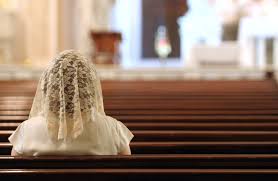
Saint Linus and Sacred Tradition: The Apostolic Foundation of Head Covering
Saint Linus: Early Church Faithfulness
Dear faithful, today we honor Saint Linus, the second successor of Saint Peter as Bishop of Rome, who served our Lord from approximately 67 to 76 AD. As Catholics, we recognize in Saint Linus not merely a historical figure, but a guardian of apostolic tradition who walked with the very apostles themselves. According to the Liber Pontificalis and other ancient sources, Pope Saint Linus decreed that women should cover their heads when entering church. This was not an innovation, but rather the faithful preservation of apostolic teaching received directly from Saint Paul. Saint Linus understood his sacred duty to maintain the deposit of faith exactly as it had been handed down from Christ through His apostles. This decree demonstrates the beautiful continuity of Sacred Tradition - how the Church, guided by the Holy Spirit, preserves and transmits the teachings of Christ through the apostolic succession.
Paul's Divine Order in 1 Corinthians 11
Let us turn to 1 Corinthians 11:3-6, where Saint Paul writes: "But I want you to understand that the head of every man is Christ, the head of a wife is her husband, and the head of Christ is God. Every man who prays or prophesies with his head covered dishonors his head, but every wife who prays or prophesies with her head uncovered dishonors her head, since it is the same as if her head were shaven." The Catechism of the Council of Trent affirms this apostolic teaching, stating: "Wives should be subject to their husbands... and as a sign of this subjection, they should, when they pray, cover their heads, as the Apostle commands." This authoritative teaching shows that the Church has always understood head covering as divinely ordained, not merely cultural. Saint Paul's reasoning here is profound and rooted in divine revelation. The covering represents this beautiful hierarchy of authority: God over Christ, Christ over man, man as head of woman. When a Catholic woman covers her head in worship, she makes a visible declaration of this divine order that reflects the very nature of the Trinity.
Angels, Glory, and Worship
In verse 10, Saint Paul gives us a remarkable reason: "That is why a wife ought to have a symbol of authority on her head, because of the angels." The covering represents the authority under which she stands as a daughter of the Church. But why "because of the angels"? Sacred Scripture and Catholic tradition teach us that angels are present during the Holy Sacrifice of the Mass and our liturgical worship, observing how we conduct ourselves before the Most High. These heavenly beings, who perfectly submit to God's authority, witness whether we too honor the divine order in our sacred worship. Saint Paul also speaks of glory in the preceding verses. Man is the glory of God, but woman is the glory of man. In the sacred liturgy, our focus should be entirely on God's glory, not our own. The mantilla or chapel veil helps ensure that the woman's natural beauty serves to direct attention to God alone.
Historical Continuity: From Apostles to Early Church
This brings us back to the wisdom of Saint Linus and the early Church Fathers. When Pope Saint Linus issued his decree on head covering, he was exercising the apostolic authority given to the successors of Peter to bind and loose, ensuring uniform observance of apostolic teaching throughout the Church. The Catechism of the Council of Trent further teaches: "It is fitting that women, following apostolic tradition, should cover their heads in church as a sign of reverence and modesty before God." This demonstrates the unbroken continuity from the apostles through Saint Linus to the Council of Trent - nearly fifteen centuries of consistent Catholic teaching. Saint Linus reminds us that the Church's authority comes not from human wisdom, but from Christ Himself, who promised that the gates of hell would not prevail against His Church.
Embracing Our Catholic Heritage
As faithful Catholics, we are called to embrace the fullness of our tradition with joy and reverence. The practice of head covering is not merely a cultural relic, but a living expression of our Catholic identity rooted in Scripture and Sacred Tradition. For our Catholic women, the mantilla or chapel veil is a beautiful symbol of your dignity as daughters of the Church. It connects you to countless generations of Catholic women who have worn this sign of reverence - from the Blessed Virgin Mary herself to the saints and martyrs who have gone before us. Let us approach this practice not as a burden, but as a privilege - a visible sign of our Catholic faith and our submission to the authority of Christ exercised through His Church. In a world that often rejects traditional expressions of faith, may our fidelity to these practices be a witness to the beauty and truth of Catholic tradition. -F.D.

